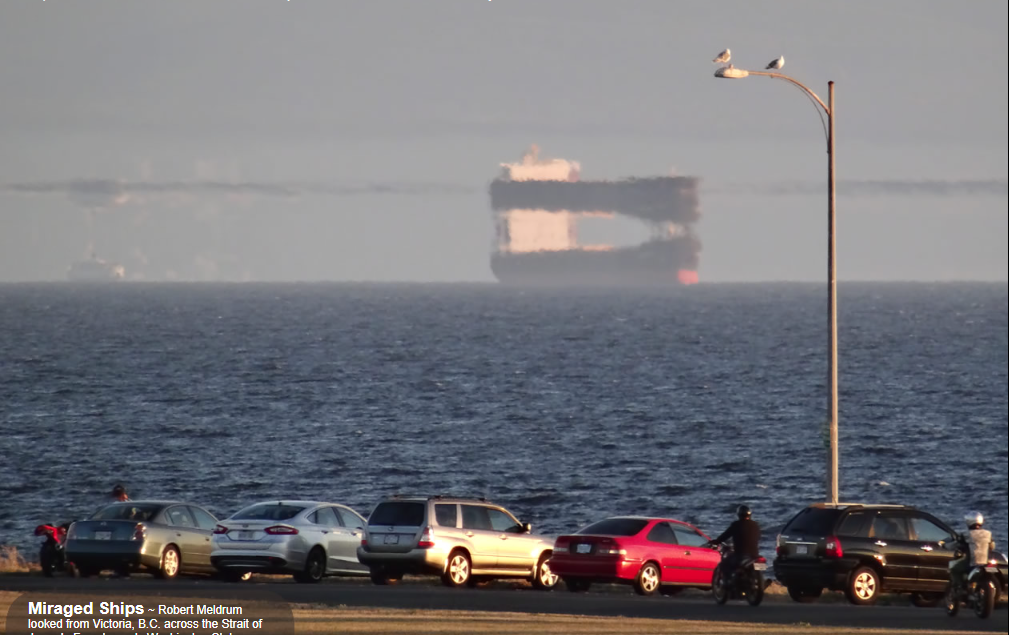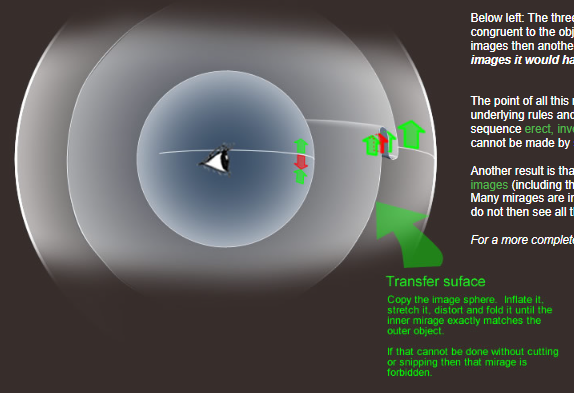Miraged Ships - Strait of Juan de Fuca - OPOD
Miraged Ships - Strait of Juan de Fuca: An Optical Phenomenon
The Strait of Juan de Fuca, located between Victoria, B.C. and Washington State, is renowned for its mesmerizing mirages. These optical illusions occur when cold water from the Pacific Ocean meets warmer continental air, creating a temperature inversion. Rays of light passing through this inversion layer undergo refraction, leading to the formation of mirages. In this article, we will delve deeper into the fascinating world of miraged ships in the Strait of Juan de Fuca and explore the science behind these captivating phenomena.
The Miraged Ships
One such example of a mirage captured by Robert Meldrum is the sight of a large ship, known as a bulk carrier, sailing with its inverted form hovering above it. Above the inverted image, another erect image of the ship can be observed. It is important to note that mirages typically exhibit alternate inverted and erect images. In addition to the bulk carrier, Meldrum also captured the Black Ball Line MV Coho, a vehicle ferry traveling from Victoria, B.C. to Port Angeles, WA, which also displayed inverted and erect images sailing above it.
The Science Behind Mirages
To understand how mirages form, we need to examine the interaction between light rays and the temperature inversion layer. When a ray of light, such as ray 'a' from the ship's funnel, passes through the cold air without deviation, it appears unaffected. However, ray 'b' from the same point is refracted downward due to the temperature gradient, creating the illusion that it originates from a higher point. Ray 'c' from the hull experiences even stronger refraction, resulting in an image that appears to come from an even higher position. Consequently, an inverted image of the ship is formed. Furthermore, more strongly refracted rays give rise to an erect image positioned above the inverted one. With the appropriate temperature profile, another inverted image could potentially be observed above the erect image.
Exploring the Topology of Mirages
While ray diagrams provide limited insight into miraging, topology offers a more comprehensive understanding of the rules and structure governing mirages. By envisioning the mirage as being projected onto an "image sphere," we can then imagine the actual object responsible for the mirage on a larger diameter "object sphere." The refractions and curved rays occur between these two spheres. To simplify the analysis, a copy of the inner sphere, known as a transfer surface, is created and inflated towards the outer object sphere. The goal is to align the mirage images on the transfer surface with the single object sphere image. This process involves stretching and folding, but cutting or snipping is not allowed.
Through this rubbery playing with transfer surfaces, deep insights into the underlying rules and structure of mirages are gained. One significant revelation is that allowed mirages follow a specific sequence: erect, inverted, erect, and so on. Mirages with a sequence of erect, erect, inverted do not conform to the smooth folding of the transfer sphere. Another noteworthy finding is that complete mirages always consist of an odd number of images, including the "real" one. Attempting to fold the sphere to create an even number of images proves impossible. However, it is worth mentioning that many mirages appear incomplete due to obstructions such as the ground or an intervening air layer, preventing the observation of all the images.
The Curious Case of Rule Breaking
Occasionally, mirages captured by photographers like Robert Meldrum may exhibit sequences that seemingly defy the established rule of an erect-inverted-erect pattern. Upon closer inspection, it becomes evident that these rule-breaking instances are a result of extreme stooping or towering. In some cases, individual components of the sequence may be compressed almost into a line, while others may be vertically stretched. These variations in the temperature profile can lead to deviations from the typical mirage sequence.
In conclusion, the Strait of Juan de Fuca offers a captivating display of miraged ships, showcasing the mesmerizing interplay between cold water and warm continental air. The formation of mirages involves the refraction of light rays through a temperature inversion layer, resulting in the creation of inverted and erect images. By exploring the topology of mirages, we gain a deeper understanding of the underlying rules and structure governing these optical phenomena. While most mirages adhere to an erect-inverted-erect pattern, occasional deviations can occur due to extreme stooping or towering. The study of mirages continues to unravel the mysteries of light and atmospheric optics, captivating both scientists and observers alike.

Miraged Ships ~ Robert Meldrum looked from Victoria, B.C. across the Strait of Juan de Fuca towards Washington State.
The large ship is a bulk carrier. Its inverted form sails above it. Above that is a third image, this time the right way up. All mirages in their purest form have alternate inverted and erect images.
At left is the Black Ball Line MV Coho, a vehicle ferry on its way from Victoria B.C. to Port Angeles, WA. It too has inverted and erect images sailing above it.
The Strait of Juan de Fuca is famous for its mirages. The ingredients are cold water flowing in from the Pacific Ocean topped by warmer continental air. The lower layer of ocean cooled air forms a temperature inversion. Rays refracted across it form the mirages.
©Robert Meldrum, shown with permission

Rays across an inversion layer - Superior mirages
Ray 'a' from the ship's funnel passes through cold air and is undeviated. But ray 'b' from the same point is refracted downwards to the eye and appears to come from a point higher up. Ray 'c'' from the hull is refracted even more strongly in the gradients between the cold and warm air. It appears to come from higher up still. The result is an inverted image of the ship. More strongly refracted rays form an erect ship image above the inverted one. With the right temperature profile there would be another inverted image above that.

Rubber Spheres & Mirages - Some Topology
Ray diagrams like the one above say almost nothing in general about miraging. Topology does. It reveals rules governing mirages. What is possible and what is not.
Start by imagining what we see is pasted onto a transparent sphere called an 'image sphere'.
The real object creating the mirage is imagined pasted onto a larger diameter 'object sphere'.
The refractions and curved rays occur between the two spheres but we no longer need to worry about how or why the ray paths get curved.
Instead we try to transform the mirage on inner sphere into the object on the outer sphere.
We make a copy of the inner sphere called a transfer surface. Then we Inflate it so that it expands towards the outer object sphere. The game is to somehow make the mirage images pasted on the transfer sphere exactly match the single object sphere image. Stretching and folding is allowed, cutting or snipping are not.
Below left: The three mirage images are made to overlay each other and be congruent to the object by folding the transfer sphere twice. If there had been five images then another two folds would have done the trick. Had there been four images it would have been quite impossible.
The point of all this rubbery playing is that it generates deep insights into the underlying rules and structure of mirages. For example, allowed mirages have the sequence erect, inverted, erect,.. Mirages like erect, erect, inverted are not. They cannot be made by smooth folding of the transfer sphere.
Another result is that - in a complete mirage - there are always an odd number of images (including the 'real' one). Try folding the sphere to make an even number! Many mirages are incomplete because the ground or an air layer cuts them off - we do not then see all the images.
For a more complete description see this page.

Rule breaking?
Another of Robert Meldrum's mirages. It's not easy to separate the images but it looks as though the central one(s) disobey the rule that the sequence must always be erect, inverted, erect...
What happens is that the sequence is always there but sometimes the temperature profile causes individual components to be compressed almost into a line (extreme stooping). Equally, others can be vertically stretched (towering).
Rays across a

Note: this article has been automatically converted from the old site and may not appear as intended. You can find the original article here.
Reference Atmospheric Optics
If you use any of the definitions, information, or data presented on Atmospheric Optics, please copy the link or reference below to properly credit us as the reference source. Thank you!
-
<a href="https://atoptics.co.uk/blog/miraged-ships-strait-of-juan-de-fuca-opod/">Miraged Ships - Strait of Juan de Fuca - OPOD</a>
-
"Miraged Ships - Strait of Juan de Fuca - OPOD". Atmospheric Optics. Accessed on November 22, 2024. https://atoptics.co.uk/blog/miraged-ships-strait-of-juan-de-fuca-opod/.
-
"Miraged Ships - Strait of Juan de Fuca - OPOD". Atmospheric Optics, https://atoptics.co.uk/blog/miraged-ships-strait-of-juan-de-fuca-opod/. Accessed 22 November, 2024
-
Miraged Ships - Strait of Juan de Fuca - OPOD. Atmospheric Optics. Retrieved from https://atoptics.co.uk/blog/miraged-ships-strait-of-juan-de-fuca-opod/.